ã€introduction】
Nanobiomedicine is an emerging field of science and technology. Because nanomaterials range from 0.1 to 100 nm, they are especially suitable for molecular level operations. Nanomaterials can repair mutated genes, kill cancer cells and bacteria and viruses that invade the human body, release drugs at appropriate time, and trace substances needed by the human body. Nanomaterials have extremely important applications in cancer treatment and have great potential value.
[Introduction]
Recently, Shi Jianlin and Chen Yu (common communication) of the Shanghai Institute of Ceramics of the Chinese Academy of Sciences and others have loaded natural glucose oxidase (GOD, enzyme catalyst) and ultra-small Fe3O4 nanoparticles (inorganic nano-enzyme catalyst) into degradable macropores. A nano-catalyst GOD-Fe3O4@DMSN (GFD NCs) with linkage effect was prepared in dendritic silica nanoparticles (DMSN), and the non-toxic nano-catalyst with good biocompatibility was delivered to the tumor site in the tumor. Under the stimulation of microenvironment excess glucose nutrition and slightly acidic metabolic environment, it is transformed into a reactive oxygen species-hydroxyl radical which is highly toxic to tumor cells, which induces apoptosis of tumor cells. Related results were published in Nat. entitled "Tumor-selective catalytic nanomedicine by nanocatalyst delivery". Commun. .
[Graphic introduction]
Fig.1 Schematic diagram of preparation and catalytic reaction of GFD NCs nanocatalyst
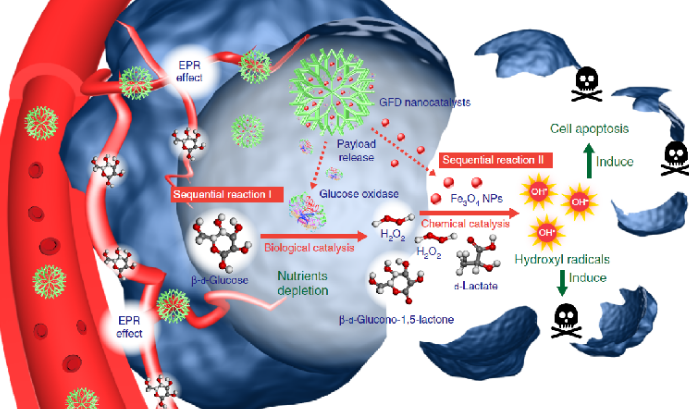
a) schematic diagram of the synthesis of nanocatalyst GFD NCs;
b) Schematic diagram of the tumor-specific treatment of the nanocatalyst GFD NCs linkage catalytic reaction.
Figure 2 Structure and composition of the material
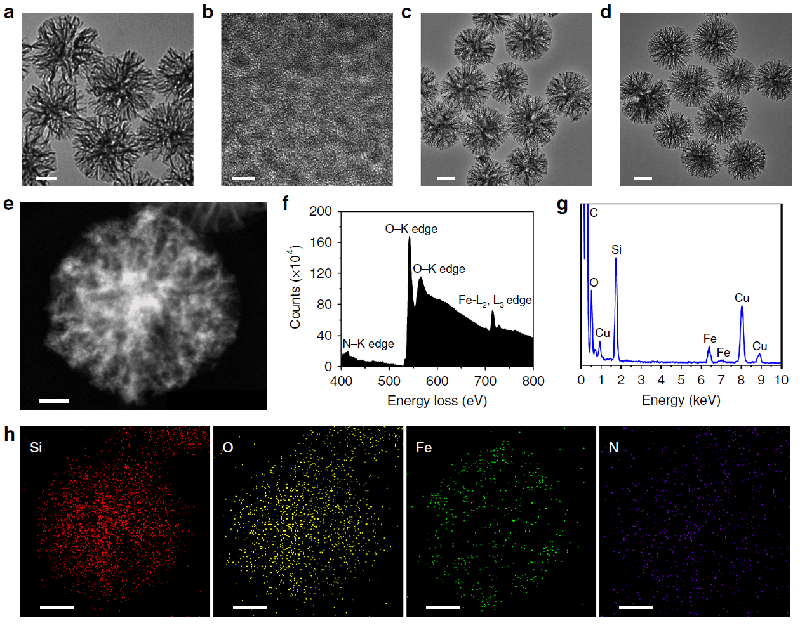
a) TEM image of the DMSN vector, scale bar: 100 nm;
b) TEM image of ultra-small Fe3O4 nanoparticles, scale bar: 5 nm;
c) TEM image of Fe3O4@DMSNs Nanocatalysts, scale bar: 100 nm;
d) TEM image of nanocatalyst GFD NCs, scale bar: 100 nm;
e) dark field image of nanocatalyst GFD NC, scale bar: 50 nm;
f) electron energy loss spectrum of the nanocatalyst GFD NC;
g) EDS spectrum of nanocatalyst GFD NC;
h) Surface distribution of the EDS element of the nanocatalyst GFD NC, scale bar: 50 nm.
Figure 3 Characterization of in vitro catalytic performance of nanocatalyst GFD NCs
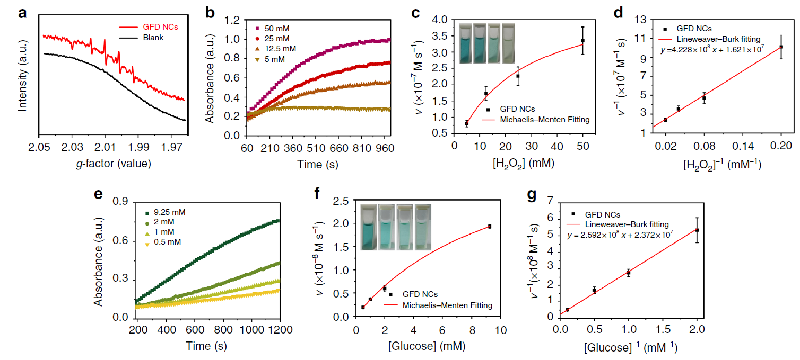
a) ESR spectra of nanocatalyst GFD NCs (10 μg/ml) in the presence/absence of glucose (10 mM);
B-g) The Michaelis steady state kinetics of hydroxyl radical generation by 3,3',5,5'-tetramethylbenzidine (TMB) as an indicator. Absorbance change of nanocatalyst GFD NCs in the presence of different concentrations of (b) hydrogen peroxide (50, 25, 12.5 and 5 mM) or (e) glucose (9.25, 2, 1 and 0.5 mM) (c-d) Fe3O4 nanoparticles and (f-g) GOD-Fe3O4 linkage (c, f) Michaelis-Menten steady state kinetics and (d, g) Lineweaver-Burk plot.
Figure 4 In vitro cytotoxicity and ROS detection
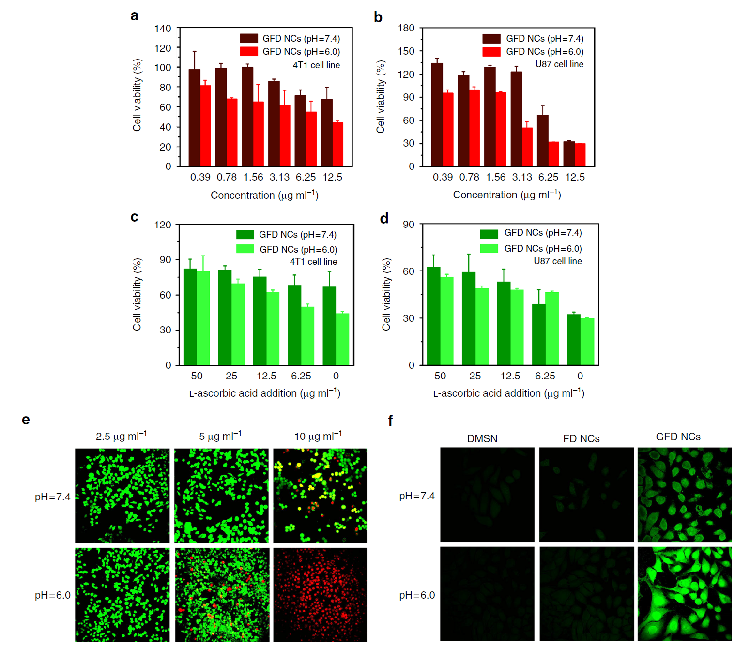
a) Toxicity of nanocatalyst GFD NCs to 4T1 cancer cells under neutral (pH = 7.4) and acidic (pH = 6.0) conditions;
b) the toxicity of the nanocatalyst GFD NCs to U87 cancer cells under neutral (pH = 7.4) and acidic (pH = 6.0) conditions;
c) cytotoxicity data of ascorbate resistant nanocatalyst GFD NCs against 4T1 cancer cells;
d) cytotoxicity data of ascorbate resistant nanocatalyst GFD NCs against U87 cancer cells;
e) After neutral (pH=7.4) and acidic (pH=6.0), 4T1 cancer cells were co-incubated with different concentrations (2.5, 5, 10 μg/mL) of nano-catalyst GFD NCs Living dead double stained confocal image;
f) Confocal images of ROS fluorescent probe staining of 4T1 cancer cells co-incubated with DMSN, FD NCs and GFD NCs under neutral (pH = 7.4) and acidic (pH = 6.0) conditions.
Figure 5 Degradation behavior of nanocatalyst GFD NCs
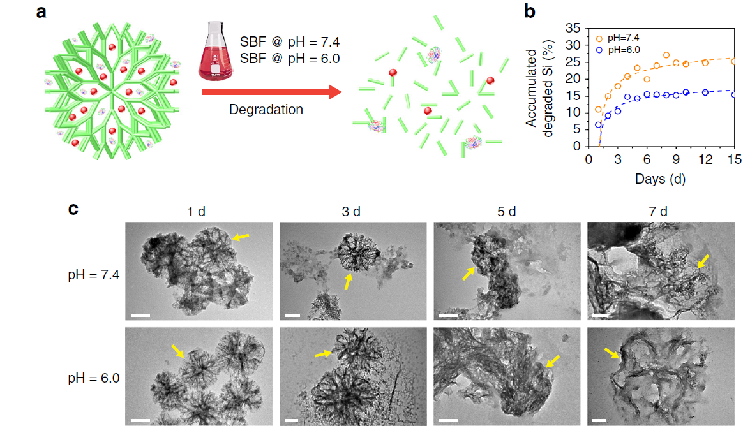
a) Schematic diagram of the degradation process of the nanocatalyst GFD NCs;
b) cumulative degradation of silicon-containing product concentration measured by ICP under neutral (pH = 7.4) and acidic (pH = 6.0) simulated body fluid (SBF) conditions;
c) TEM images of degradation products of nanocatalyst GFD NCs at different time points (1, 3, 5, 7 days) under neutral (pH = 7.4) and acidic (pH = 6.0) SBF conditions; Scale bar: 100 nm.
Figure 6 Pharmacokinetics of nanocatalyst GFD NCs
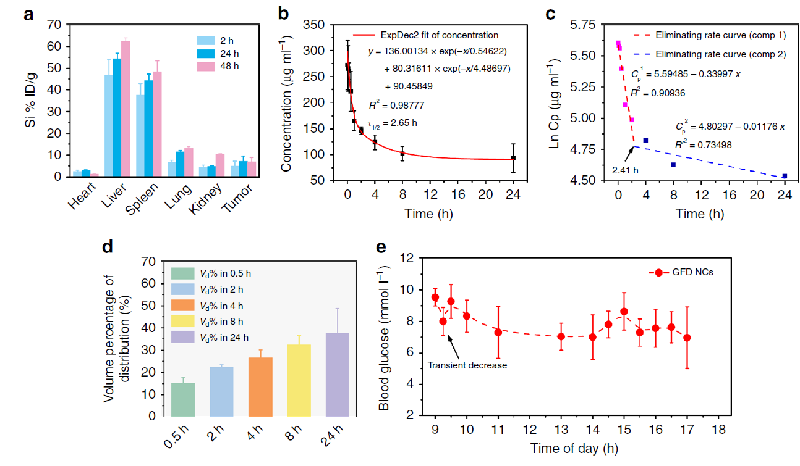
a) In vivo distribution of Si in major organs and tumors after intravenous administration of GFD NCs (n = 3) in mice for 2, 24, and 48 hours;
b) Blood half-life curve of mice injected with GFD NCs (n = 5). The half-life (Ï„ 1/2) calculated is approximately 2.65 h;
c) The metabolic rate curve of the intravenous injection of GFD NCs in mice (according to the ln(Cp)-T relationship) is consistent with the two-compartment pharmacokinetic model;
d) percentage of apparent distribution volume (Vd%) of intravenous GFD NCs (n = 5) in mice;
e) Blood glucose level curve within 8 hours after intravenous injection of GFD NCs (n = 3) in mice; after injection of the material, the blood glucose of the mice showed a transient decrease in blood glucose within 30 minutes, and the blood glucose of the mice returned to normal levels within 1 hour.
Figure 7 In vivo in vivo catalytic treatment of 4T1 and U87 tumor models by nanocatalyst GFD NCs
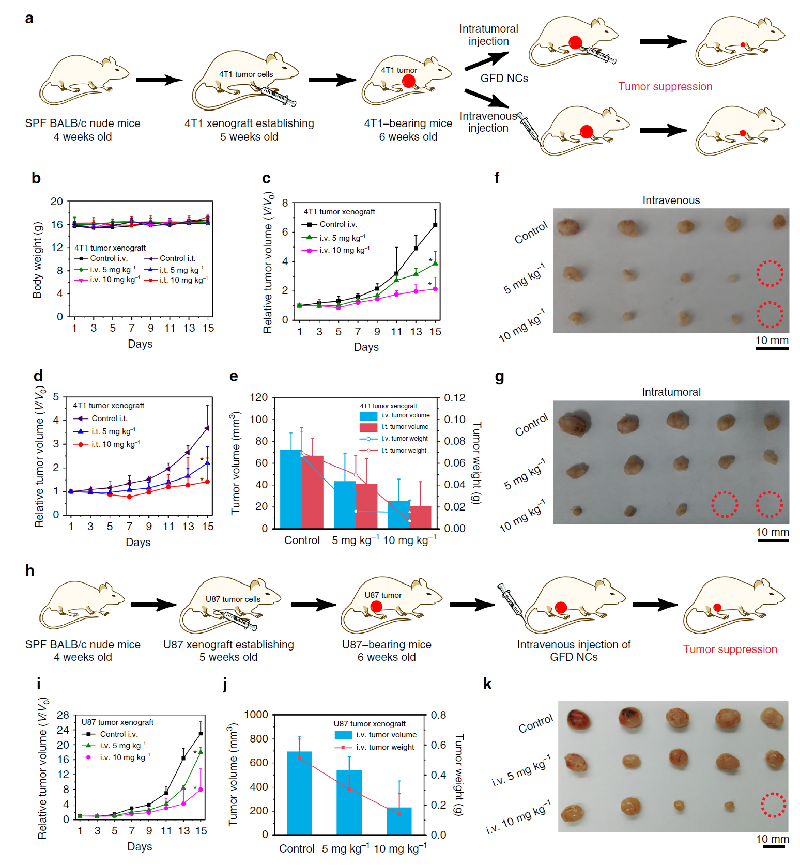
a) Schematic diagram of the establishment and treatment of 4T1 in vivo tumor model; the dosage form of nanocatalyst GFD NCs is divided into tail vein injection (i.v.) and intratumoral injection (i.t.);
b) the body weight change curve of the 4T1 model tumor-bearing mice during the treatment period;
c) 4T1 tumor relative size change curve of tumor-bearing mice after intravenous injection of normal saline (control group) and different doses of GFD NCs (treatment group);
d) 4T1 tumor relative size change curve of tumor-bearing mice after intratumoral injection of normal saline (control group) and different doses of GFD NCs (treatment group);
e) volume and weight curves of tumors in each group after a 15-day treatment period;
f) Digital images of tumors dissected in each group after 15 days of tail vein injection, red circles indicate that the tumor was eliminated;
g) Digital images of the tumors dissected in each group after 15 days of intratumoral injection, with red circles indicating that the tumor was eliminated;
h) Schematic diagram of the establishment and treatment of U87 tumor model in vivo; nano-catalyst GFD NCs is administered by tail vein injection (i.v.);
i) U87 tumor relative size change curve of tumor-bearing mice after intravenous injection of normal saline (control group) and different doses of GFD NCs (treatment group);
j) volume and weight curves of tumors in each group after a 15-day treatment period;
k) Digital images of tumors dissected in each group after 15 days of tail vein injection, red circles indicate that the tumor was eliminated;
ã€summary】
Shi Jianlin and Chen Yu and others have introduced the concept of continuous catalysis into nanomedicine by carefully designing multifunctional nanocatalysts with excellent biodegradability and biocompatibility, thus effectively inhibiting tumor growth. In the experiment, natural GOD and ultra-small Fe3O4 nanoparticles were simultaneously loaded into a large pore size DMSN to construct a continuous catalytic nano-catalyst GFD NCs. This has successfully demonstrated the concept of linked catalytic nanomedicine therapy for GFD NCs.
Nutrition supplements are mostly made into pills, tablets, capsules, granules or oral liquids, etc., and are taken alone with meals. They can be composed of amino acids, polyunsaturated fatty acids, minerals and Vitamins, or only composed of one or more vitamins; they can also be composed of one or more dietary ingredients, in addition to amino acids, vitamins, minerals. In addition to nutrients such as substances, there may also be herbs or other plant components, or concentrates, extracts or compositions of the above components.
Nutrition Supplement,Food Grade Vitamin,Dietary Supplement,Nicotinamide Mononucleotide Capsule
Hunan Insen Biotech Co., Ltd , https://www.insenhealth.com